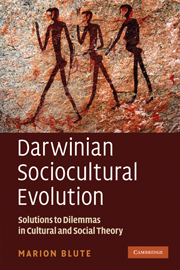Book contents
- Frontmatter
- Contents
- Preface: a postmodern metanarrative
- Acknowledgments
- 1 Introduction
- 2 History: where did something come from?
- 3 Necessity: why did it evolve?
- 4 Competition, conflict and cooperation: why and how do they interact socially?
- 5 The ideal and the material: the role of memes in evolutionary social science
- 6 Micro and macro I: the problem of agency
- 7 Micro and macro II: the problem of subjectivity
- 8 Micro and macro III: the evolution of complexity and the problem of social structure
- 9 Evolutionism and the future of the social sciences
- References
- Index
8 - Micro and macro III: the evolution of complexity and the problem of social structure
Published online by Cambridge University Press: 05 June 2012
- Frontmatter
- Contents
- Preface: a postmodern metanarrative
- Acknowledgments
- 1 Introduction
- 2 History: where did something come from?
- 3 Necessity: why did it evolve?
- 4 Competition, conflict and cooperation: why and how do they interact socially?
- 5 The ideal and the material: the role of memes in evolutionary social science
- 6 Micro and macro I: the problem of agency
- 7 Micro and macro II: the problem of subjectivity
- 8 Micro and macro III: the evolution of complexity and the problem of social structure
- 9 Evolutionism and the future of the social sciences
- References
- Index
Summary
INTRODUCTION
The concept of “progress” hovers about all questions pertaining to complexity but since progress is inherently a normative or evaluative concept it cannot be answered scientifically. The scientific problem of complexity can be divided into three broad categories – ecological, individual and social. The problem of ecological complexity is what determines the number of kinds of things (species), how new kinds arise (the process of speciation), and whether there is an overall trend toward increased complexity as they do. These are discussed in Section 8.2 below.
The problem of individual complexity is the problem of, apart from the issue of more kinds and trends – when new, more complex kinds of individuals do arise, how they do so. Biologically, how did life get from prokaryotic cells to the eukaryotic to multicellular individuals to eusocial colonies? How did human societies get from lineages to clans to tribes to nations to empires? How did weapons get all the way from spears to Intercontinental Ballistic Missiles and joint stock companies all the way from the East India Company to behemoths like Exxon Mobil, General Electric and Wal-Mart? This is discussed in Section 8.3 below.
The problem of social complexity is a kind of half-way house between these, the problem of how interacting social groups coalesce but also disaggregate so that while selection on a higher level may be involved, nevertheless they do not form new permanent aggregate individuals.
- Type
- Chapter
- Information
- Darwinian Sociocultural EvolutionSolutions to Dilemmas in Cultural and Social Theory, pp. 182 - 198Publisher: Cambridge University PressPrint publication year: 2010



